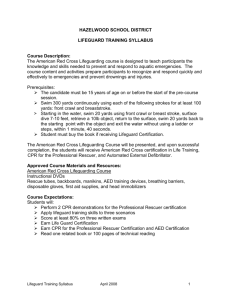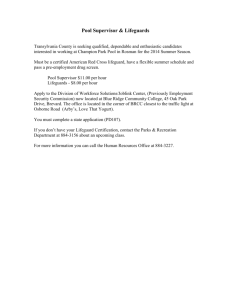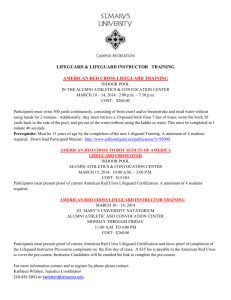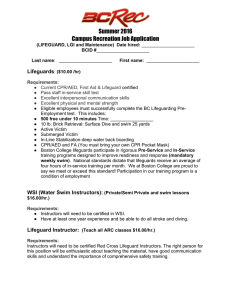C P URRICULUM
advertisement
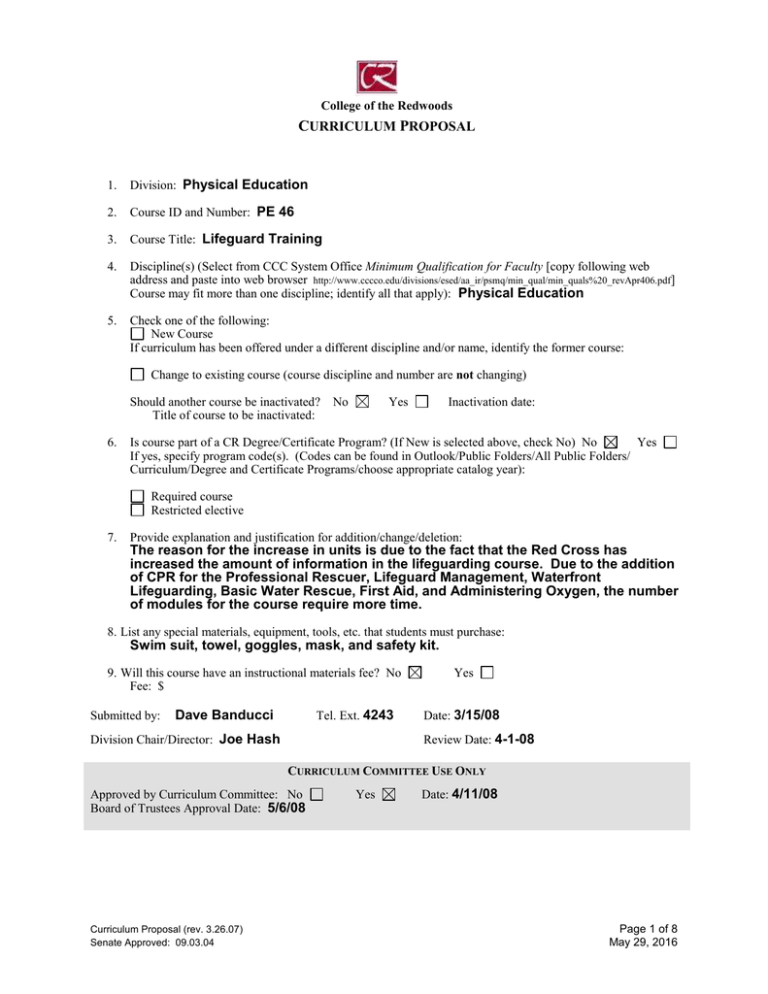
College of the Redwoods CURRICULUM PROPOSAL 1. Division: Physical Education 2. Course ID and Number: PE 46 3. Course Title: Lifeguard Training 4. Discipline(s) (Select from CCC System Office Minimum Qualification for Faculty [copy following web address and paste into web browser http://www.cccco.edu/divisions/esed/aa_ir/psmq/min_qual/min_quals%20_revApr406.pdf] Course may fit more than one discipline; identify all that apply): Physical Education 5. Check one of the following: New Course If curriculum has been offered under a different discipline and/or name, identify the former course: Change to existing course (course discipline and number are not changing) Should another course be inactivated? Title of course to be inactivated: 6. No Yes Inactivation date: Is course part of a CR Degree/Certificate Program? (If New is selected above, check No) No Yes If yes, specify program code(s). (Codes can be found in Outlook/Public Folders/All Public Folders/ Curriculum/Degree and Certificate Programs/choose appropriate catalog year): Required course Restricted elective 7. Provide explanation and justification for addition/change/deletion: The reason for the increase in units is due to the fact that the Red Cross has increased the amount of information in the lifeguarding course. Due to the addition of CPR for the Professional Rescuer, Lifeguard Management, Waterfront Lifeguarding, Basic Water Rescue, First Aid, and Administering Oxygen, the number of modules for the course require more time. 8. List any special materials, equipment, tools, etc. that students must purchase: Swim suit, towel, goggles, mask, and safety kit. 9. Will this course have an instructional materials fee? No Fee: $ Submitted by: Dave Banducci Tel. Ext. 4243 Division Chair/Director: Joe Hash Yes Date: 3/15/08 Review Date: 4-1-08 CURRICULUM COMMITTEE USE ONLY Approved by Curriculum Committee: No Board of Trustees Approval Date: 5/6/08 Curriculum Proposal (rev. 3.26.07) Senate Approved: 09.03.04 Yes Date: 4/11/08 Page 1 of 8 May 29, 2016 SUMMARY OF CURRICULUM CHANGES FOR AN EXISTING COURSE FEATURES OLD NEW Training which will provide the student with a Lifeguard Training Certificate, CPR for the Professional Rescuer, and First Aid, Community Water Safety, Head Lifeguard, and Waterfront Lifeguard certifications, which qualifies participants as non-surf lifeguards An American Red Cross Lifeguarding Course that provides entry-level lifeguard participants with the knowledge and skills to prevent, recognize and respond to emergencies and to provide care for injuries and sudden illness until emergency medical services (EMS) personnel arrive and take over. Successful completion leads to receiving the American Red Cross Certification in appropriate modules. Grading Standard Select Select Total Units 2.0 3.0 Lecture Units 1.5 2.0 Lab Units .5 1.0 Prerequisites Students must demonstrate profiency in front crawl, back crawl, breaststroke, sidestroke, elementary backstroke, and underwater swimming. None Catalog Description (Please include complete text of old and new catalog descriptions.) Corequisites Recommended Preparation Maximum Class Size Repeatability— Maximum Enrollments Other Instructor must be an authorized Lifeguard Instructor certified by the American Red Cross to certify students in Lifeguard Training, CPR for the Professional Rescuer, First Aid, Waterfront Lifeguarding, Lifeguard Management, Administering Emergency Oxygen, Basic Water Rescue. If any of the listed features have been modified in the new proposal, indicate the “old” (current) information and proposed changes. Curriculum Proposal (rev. 3.26.07) Senate Approved: 09.03.04 Page 2 of 8 May 29, 2016 College of the Redwoods COURSE OUTLINE DATE: 3/15/08 COURSE ID AND NUMBER: PE 46 COURSE TITLE: Lifeguard Training FIRST TERM NEW OR REVISED COURSE MAY BE OFFERED: Summer 2008 TOTAL UNITS: 3.0 TOTAL HOURS: 90 [Lecture Units: 2.0 [Lecture Hours: 36 Lab Units: 1.0] Lab Hours: 54] MAXIMUM CLASS SIZE: 24 GRADING STANDARD Letter Grade Only CR/NC Only Is this course repeatable for additional credit units: No Grade-CR/NC Option Yes If yes, how many total enrollments? Is this course to be offered as part of the Honors Program? No Yes If yes, explain how honors sections of the course are different from standard sections. CATALOG DESCRIPTION The catalog description should clearly state the scope of the course, its level, and what kinds of student goals the course is designed to fulfill. An American Red Cross Lifeguarding Course that provides entry-level lifeguard participants with the knowledge and skills to prevent, recognize and respond to emergencies and to provide care for injuries and sudden illness until emergency medical services (EMS) personnel arrive and take over. Successful completion leads to receiving the American Red Cross Certification in appropriate modules. Special notes or advisories: 1. Must be at least 15 years of age. 2. Must be able to swim 300 yards using the front crawl, breaststroke, and a combination of either, and demonstrate proficient knowledge of distance and stroke. 3. Must be able to swim 20 yards, surface dive 7-10 feet, retrieve a 10-pound object, return to starting point and exit the water without using the ladder, in 1 minute and 40 seconds. PREREQUISITES No Yes Course(s): Rationale for Prerequisite: Describe representative skills without which the student would be highly unlikely to succeed . COREQUISITES No Yes Rationale for Corequisite: Curriculum Proposal (rev. 3.26.07) Senate Approved: 09.03.04 Course(s): Page 3 of 8 May 29, 2016 RECOMMENDED PREPARATION No Yes Course(s): Rationale for Recommended Preparation: COURSE LEARNING OUTCOMES What should the student be able to do as a result of taking this course? State some of the objectives in terms of specific, measurable student accomplishments. 1. Demonstrate the qualities of an American Red Cross representative. 2. Demonstrate the required skills (in water rescues, approaches, and entries) at an acceptable level of performance. 3. Acquire knowledge of, and become familiar with, a wide variety of course related materials (CPR, first aid, and in line-stabilization). 4. Obtain knowledge of employment opportunities in the field. 5. Describe physical and mental skills required of a lifeguard (such as rules enforcement, patron education, and safety checks and emergency response). 6. Demonstrate in water spinal management techniques. 7. Describe knowledge of techniques providing for the health and safety of all patrons. 8. Effectively use course materials and training equipment. 9. Perform victim recognition, and scanning techniques. COURSE CONTENT Themes: What themes, if any, are threaded throughout the learning experiences in this course? 1. Knowledge of swim skills and strokes. 2. Risk management. 3. Injury prevention and patron safety. 4. Facility safety. 5. Patron surveillance. 6. Emergency preparation. 7. Lifeguard Management. 8. Basic Water Rescue. 9. Waterfront Lifeguarding. Concepts: What concepts do students need to understand to demonstrate course outcomes? 1. Ensuring health and safety. 2. Preventing and providing care for injuries. 3. Providing directions. Issues: What primary issues or problems, if any, must students understand to achieve course outcomes (including such issues as gender, diversity, multi-culturalism, and class)? 1. 2. 3. 4. 5. Social skills. Cooperation. Decision making. Diversity. Gender Equity. Skills: What skills must students master to demonstrate course outcomes? 1. Swimming. 2. Backboarding. Curriculum Proposal (rev. 3.26.07) Senate Approved: 09.03.04 Page 4 of 8 May 29, 2016 3. 4. 5. 6. 7. CPR/AED. Rescue tube. Lifeguarding techniques and knowledge Supervisory and management skills. Waterfront safety skills. REPRESENTATIVE LEARNING ACTIVITIES What will students be doing (e.g., listening to lectures, participating in discussions and/or group activities, attending a field trip)? Relate the activities directly to the Course Learning Outcomes. 1. Participating in classroom lectures, discussions and engaging in group activities. 2. Performing skills with rescue tubes and backboards. 3. Describing information learned from reading assignments. 4. Performing strokes and rescue skills. 5. Exploring and becoming familiar with rescue techniques. 6. Demonstrating, using and administering of manikins, AED's, oxygen delivery systems, breathing barriers, disposable gloves, and first aid supplies. 8. Performing water skills and rescue scenarios. ASSESSMENT TASKS How will students show evidence of achieving the Course Learning Outcomes? Indicate which assessments (if any) are required for all sections. Representative assessment tasks: Required assessments for all sections – to include but not limited to: 1. Physical swim skill testing, as well as, demonstration of lifeguarding skills. 2. Written exams and quizzes. 3. Written assignments. 4. Class participation. 5. Final exam by the Red cross and Pass with an 80%. EXAMPLES OF APPROPRIATE TEXTS OR OTHER READINGS Author, Title, and Date Fields are required Author American Title Red Cross (StayWell) Lifeguarding Date 2007 Author American Red Cross (StayWell) Author Title Date Author Title Date Title Lifeguard Management Date 2007 Other Appropriate Readings: Curriculum Proposal (rev. 3.26.07) Senate Approved: 09.03.04 Page 5 of 8 May 29, 2016 PROPOSED TRANSFERABILITY: CSU UC If CSU transferability is proposed (courses numbered 1-99), indicate whether general elective credit or specific course equivalent credit is proposed. If specific course equivalent credit is proposed, give course numbers/ titles of at least two comparable lower division courses from a UC, CSU, or equivalent institution. None General elective credit Specific course equivalent 1. , (Campus) 2. , (Campus) CURRENTLY APPROVED GENERAL EDUCATION CR CSU IGETC CR GE Category: CSU GE Category: IGETC Category: PROPOSED CR GENERAL EDUCATION Rationale for CR General Education approval (including category designation): Natural Science Social Science Humanities Language and Rationality Writing Oral Communications Analytical Thinking PROPOSED CSU GENERAL EDUCATION BREADTH (CSU GE) A. Communications and Critical Thinking A1 – Oral Communication A2 – Written Communication A3 – Critical Thinking C. Arts, Literature, Philosophy, and Foreign Language C1 – Arts (Art, Dance, Music, Theater) C2 – Humanities (Literature, Philosophy, Foreign Language) E. Lifelong Understanding and SelfDevelopment E1 – Lifelong Understanding E2 – Self-Development B. Science and Math B1 – Physical Science B2 – Life Science B3 – Laboratory Activity B4 – Mathematics/Quantitative Reasoning D. Social, Political, and Economic Institutions D0 – Sociology and Criminology D1 – Anthropology and Archeology D2 – Economics D3 – Ethnic Studies D5 – Geography D6 – History D7 – Interdisciplinary Social or Behavioral Science D8 – Political Science, Government and Legal Institutions D9 – Psychology Rationale for inclusion in this General Education category: Same as above Curriculum Proposal (rev. 3.26.07) Senate Approved: 09.03.04 Page 6 of 8 May 29, 2016 Proposed Intersegmental General Education Transfer Curriculum (IGETC) 1A – English Composition 1B – Critical Thinking-English Composition 1C – Oral Communication (CSU requirement only) 2A – Math 3A – Arts 3B – Humanities 4A – Anthropology and Archaeology 4B – Economics 4E – Geography 4F – History 4G – Interdisciplinary, Social & Behavioral Sciences 4H – Political Science, Government & Legal Institutions 4I – Psychology 4J – Sociology & Criminology 5A – Physical Science 5B – Biological Science 6A – Languages Other Than English Rationale for inclusion in this General Education category: Same as above Upon successful completion of this course participant will receive certification to lifeguard at a pool, or waterfront, and be knowledgeable and certified in CPR/FPR-AED, as well as, manage other lifeguards, and administer oxygen. Curriculum Proposal (rev. 3.26.07) Senate Approved: 09.03.04 Page 7 of 8 May 29, 2016 FOR VPAA USE ONLY PROGRAM AND COURSE NUMBER PE-46 TECHNICAL INFORMATION 1. Department: PHED Physical Education 16. CoRequisite Course: None 2. Subject: PE 17. Recommended Prep: None Course No: 46 3. Credit Type: D Credit Degree Applicable 18. Maximum Class Size: 24 4. Min/Maximum Units: 3.0 to 19. Repeat/Retake: NR No repeats variable units 5. Course Level: E Not Occupational 20. Count Retakes for Credit: yes no 6. Academic Level: UG Undergraduate 21. Only Pass/No Pass: yes no 7. Grade Scheme: UG Undergraduate 22. Allow Pass/No Pass: yes no 8. Short Title: LIfeguard Training 23. VATEA Funded Course: yes no 9. Long Title: Lifeguard Training 24. Accounting Method: W Weekly Census 10. National ID 11. Local ID (CIP): (TOPS): 31.9999 083570 12. Course Types: Level One Basic Skills: NBS Not Basic Skills 25. Disability Status: N Not a Special Class 26. Billing Method: T-Term 27. Billing Period: R-Reporting Term 28. Billing Credits: 3.0 Level Two Work Experience: NWE Not Coop Work Experience 29. Purpose: A Liberal Arts Sciences Level Three: 30. Articulation No. Placeholder for GE OR (CAN): DOES NOT APPLY 31. Articulation Seq. Level Four: If GE : Choose One: 32. Transfer Status: A Transfers to both UC/CSU (CAN): 13. Instructional Method: LL Lecture/Lab 33. Equates to another course? 14. Lec TLUs: 3.0 Contact Hours: 36 Lab TLUs: 3.0 Contact Hours: 54 Lecture/Lab TLUs: Contact Hours: 34. The addition of this course will inactive number). Inactive at end of term. (course number). 15. Prerequisite: None Particular Comments for Printed Catalog. . Curriculum Approval Date: 4/11/08 Curriculum Proposal (rev. 3.26.07) Senate Approved: 09.03.04 Page 8 of 8 May 29, 2016 (course
